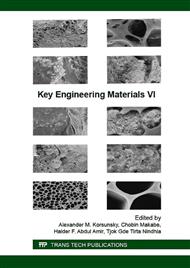p.255
p.263
p.268
p.273
p.278
p.283
p.291
p.297
p.304
Fabrication and Characterization of Ultra Water Repellent Surfaces on Aluminum Alloy Substrate
Abstract:
The fabrication of metallic ultra water repellent surfaces is of great significance to many industrial and scientific areas. Ultra water repellent surfaces on aluminum alloy substrates were fabricated with acidic etching and fluoroalkyl silane coating method. The prepared surfaces exhibit good water repellent behaviors with water contact angles (WCA) larger than 150° and contact angle hysteresis (CAH) about 5°. The resultant surfaces were examined using scanning electron microscope (SEM). The results show that a kind of hierarchical roughness in micro-nanoscale is formed, which plays a key role for the fabrication of ultra water repellent surfaces. Fancy phenomena such as "chair-shaped flow", "flow orientation" and "sinusoidal flow" were observed when water flowed in a rectangular conduit constructed with one ultra water repellent wall and one super hydrophilic wall on the opposite side. The observations reveal some characteristics of water flow in ultra water repellent conduits.
Info:
Periodical:
Pages:
278-282
Citation:
Online since:
August 2016
Authors:
Price:
Сopyright:
© 2016 Trans Tech Publications Ltd. All Rights Reserved
Share:
Citation:


